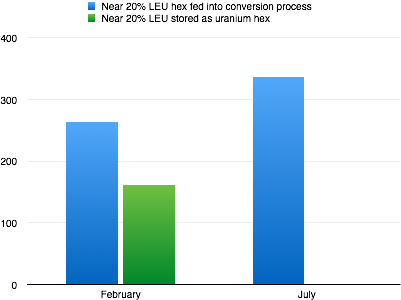Reports
Iran’s Near 20 Percent Stock: Status and Need to Reduce Size
by David Albright and Paulina Izewicz
July 31, 2014
On July 20, 2014, the International Atomic Energy Agency (IAEA) confirmed in its report on the implementation of the interim agreement, the Joint Plan of Action, that Iran had completed the down-blending and conversion into oxide of its near 20 percent low enriched uranium (LEU) hexafluoride stocks.1 As of April 14, Iran finished down-blending its near 20 percent enriched LEU hexafluoride stock, which amounted to a total of 104.56 kg. Since April 14, it blended down an additional 3.84 kg, which had previously been in storage cylinders in the form of residues. As of June 19, 2014, it had also fed 100 kg of the remaining near 20 percent LEU hexafluoride into the conversion process at its Fuel Plate Fabrication Plant at Esfahan.In its July 20, 2014 report, the IAEA also provided an accounting of an additional 0.7 kg of near 20 percent enriched LEU hexafluoride. A total of 0.6 kg were used by the IAEA as reference material for mass spectrometry, and were under IAEA seal. The IAEA has also taken an additional 0.1 kg in samples.
Table 1 and Figure 1 detail the status of the near 20 percent LEU stocks at the end of the interim period under the Joint Plan of Action. As can be seen, Iran’s oxide stock of near 20 percent LEU is large; in fact, it is sufficiently large that if it were reconverted into hexafluoride form, it could produce, if further enriched, enough weapon-grade uranium for a nuclear weapon. Since reconversion is straightforward and can be done in a matter of months, any long term agreement limiting Iran’s nuclear program should reduce the size of this stock, via down-blending or shipment overseas, to below 100 kilograms.2
Table 1. July 20, 2014 inventory and fate of UF6 enriched up to 20 percent LEU (hexafluoride mass)

Source: Status of Iran’s Nuclear Programme in relation to the Joint Plan of Action, July 20, 2014. * Estimate. The IAEA has not yet reported on the precise fate of the pre-January 2014 stock; however, a vast majority of the material was fed into the conversion process. Consequently, this estimate carries a small margin of error. **Includes 1.6 kg downblended previously.
Figure 1. Status at Beginning and End of Interim Period, (kg LEU hexafluoride).

Note: This figure demonstrates that while one chemical form of the near 20 percent enriched uranium (uranium hexafluoride) was eliminated, the other (uranium oxide) increased. Source: Status of Iran’s Nuclear Programme in relation to the Joint Plan of Action, July 20, 2014.
1 IAEA Director General, Status of Iran’s Nuclear Programme in relation to the Joint Plan of Action, GOV/INF/2014/16, July 20, 2014, http://isis-online.org/uploads/isis-reports/documents/JPOA_IAEA_update_20Jul2014_1.pdf 2 David Albright, Patrick Migliorini, Christina Walrond, and Houston Wood, “Update on Iran’s Total Near 20 Percent Enriched Uranium Stock, ISIS Report, March 11, 2014, http://isis-online.org/uploads/isis-reports/documents/twenty_percent_stock_march_11_2014-final.pdf

 twitter
twitter